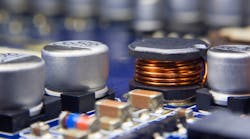Download this article in PDF format.
Flyback transformers come in two flavors: CCM (continuous conduction mode) and DCM (discontinuous conduction mode). The DCM version is the one we will develop here.
The idea of the DCM flyback is that the SEC (secondary) current drops back to zero before the next ON time for the PRI (primary). Generally, a DCM flyback is designed at the point between CCM and DCM.
When the switch is ON, the PRI inductance is storing energy due to a PRI current. The moment the switch is turned OFF, the energy stored is then:
This energy is then transferred to the SEC side where the load attached depletes that energy. The DCM is depleted entirely of its SEC energy before the next ON time the PRI sees. The number of times per second this occurs is the power delivered and is this energy multiplied by the frequency.
Now, the voltage across the PRI inductance is given as:
This says the peak voltage and the PRI duty cycle (use MAX duty cycle) are equal to the inductance, peak PRI current, and frequency.
We can then arrange the power equation as follows:
Substituting one into the other we get:
Therefore, we have found the peak current reached in the PRI side to be:
With this current, we can then find the needed PRI inductance by setting the two equations above to be equal to each other:
Now we can find SEC inductance using the same idea used for the PRI inductance. We assume here power is conserved and there are no losses (ideal case). If we assume, as we did, that we’re on the “cusp” of continuous conduction mode, then the SEC duty cycle is one minus the PRI duty cycle.
The peak SEC current is found exactly the same way as the peak PRI current, but using the SEC voltage and SEC duty cycle:
Likewise, the SEC inductance is found as:
The turns ratio for DCM is:
Substituting using previously found values of PRI and SEC inductance:
And finally substituting using previously found values of PRI and SEC peak currents:
This leads to the following equation:
We’ve now found SEC inductance and SEC peak current using the same ideas as those used to find PRI inductance and PRI peak current. Both the current and inductance were derived from basic and well-understood/known laws governing inductor energy and voltage:
Having a turns ratio can help because this turns ratio accounts for an input duty cycle. As a result, it will correctly yield both a SEC inductance and a SEC peak current using the transformer concept of a relation between PRI and SEC values through this turns ratio.
Since inductance is a function of turns squared, the SEC inductance is related to PRI inductance through the square of this ratio, therefore:
And peak SEC current is related by the inverse of this ratio:
Ok, now we need to find the MIN number of PRI turns. We’ll use the inductor equation (easily derivable from Faraday’s Law of Induction and the voltage across an inductor):
Indefinite integration yields:
We know the peak PRI current and the PRI inductance. Choose a core with an appropriate core area and use a flux density that you want as a MAX flux density for your core to obtain the MIN number of PRI turns:
SEC turns are just a function of the turns ratio and these PRI turns:
Now set/define the gapped AL value for the transformer as the ratio of the PRI inductance to the square of the PRI turns (this can be converted to an actual gap distance if needed by using equations of reluctance):
The only item left would be to choose an appropriate wire gauge. You can use a current density of 2~4 A/mm2 to get this. If the DCR is quite low, you can likely go larger, but the 2 to 4 range is most always safe; we’ll use 3 here. Also, remember that the currents found in the above work are peak currents. You can use ½ of these peak values to determine average currents.
This wire diameter should work. Keep in mind flybacks are usually switched at high frequencies; therefore, using solid gauge wire will likely not be a good idea due to skin-depth issues. So, choose an appropriate Litz wire of an equivalent gauge/diameter.
If, after you’re done, you find the bare copper wire area to be more than ~ 40% the available bobbin window area, then your part is likely too small and the core size needs to be increased. Therefore, go up a size, redo all that’s above, and check again.
This is an iterative process that will result in a transformer that meets your needs while being about as small as possible in doing so.
Early on, it was stated to use the MAX duty cycle. In this way, one can be sure they remain in DCM by decreasing the actual duty cycle. Then, less energy is transferred from PRI to SEC, and as such, the SEC can subsequently deplete what energy it gets before the start of the next PRI ON time.
Remember, too, that all of this accounts for no core losses, no regulation due to DCR, no efficiency requirement, no leakage flux, no parasitic effects at all, etc. This is the ideal case and is not reality, but these equations and this approach will certainly get you quite close to what you need.
Craig Lombard is Electrical Engineering Manager at CET Technology.





































